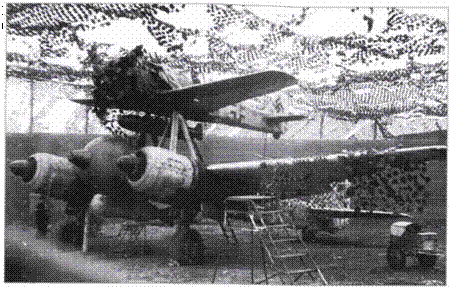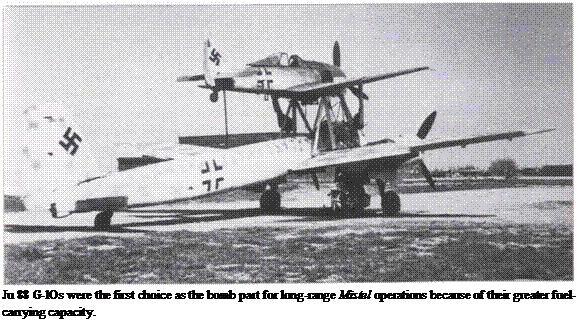Operations Begin
Following the missions against the Normandy invasion fleet in the summer of 1944, there was a pause in Mistel activities for several months which was only brought to an end when the necessity arose to demolish bridges and so protect Reich territory. On 30 January the Luftwaffe General Staff incorporated KG(Jagd) 30 into KG 200 as Mistel Gruppe II./KG 200, revoking earlier plans to convert the unit to the Me 262. Pilots were trained at Prague from February where losses occurred due to the unusual flight configuration and enemy fighters.
Operation Eisenhammer, the planned destruction of important targets in the USSR, had less sense behind it with every passing day. According to British aerial reconnaissance on 24 February, for example, Mistel operations were being planned against British fleet units from occupied Denmark. The Eastern Front had become catastrophic. A numerically and materially superior enemy faced assorted weak German units whose Panzers and heavy artillery often existed only on paper. Fuel was so scarce that it could only be released in the direst emergency. The Luftwaffe therefore looked for opportunities to strike at the enemy lines of supply, particularly by attacks on the Vistula bridges used by the Red Army.
![]()
 |
On 1 March KG 200’s Kommodore, Oberstleutnant Baumbach, ordered the bridges at Deblin, Sandomierz and Warsaw destroyed. Six M 1 and eight M 3B
Mistel were to attack all three simultaneously if the weather was right. Three attack groups with three, five and six Mistel, each with three pathfinders, was assembled. The Mistel would start from Burg near Magdeburg and Jiiterbog Damm, heading for Warsaw with the fighter cover keeping below the clouds. Flight leader was Oberleutnant Pilz (II./KG 200). The guidance Bf 109s were to land afterwards at Stolp, Vietker-Strand or Kolberg (Kolobrzeg); the Fw 190 pilots had longer range and could make for the nearest airfields in Bohemia or Saxony. Because of bad weather, this promising attack was called off at the last moment and provisionally cancelled.
On 8 March four Mistel from II./KG 200 controlled tactically by Battle Unit Helbig (an ad hoc force commanded by Oberst Helbig and comprising various bomber and other units) attacked important Oder bridges at Goritz. The first Ju 88 bomb received a hit to rudder and ailerons and fell well wide of the target. The second struck the railway bridge dead centre and collapsed it. Ju 88 and Ju 188 escort aircraft kept the enemy anti-aircraft batteries quiet using ten AB 500 (SD1) and 22 AB 70 (SD1) bombs although a Ju 188 A-2 was hit by ground fire and crashed south-west of Fiirstenwalde after the crew baled out. JG 11 provide fighter cover to the Oder.
By 21 March, II./KG 200 had 14 older M 1 pairs, two M 2s and 17 M 3s. A KG 200 report dated 28 March complained that Mistel operations against pontoon or other emergency bridges were uneconomic and ineffective because the crossings were narrow and thus very difficult to hit. In the opinion of Werner Baumbach sticks of bombs or guided bombs were far more likely to be successful.
Operations against bridges often failed because the Mistel tactic was not very suitable for mobile commands. It was difficult to avoid disorganisation when transferring Mistel between airfields. Because of Allied air superiority Mistel could realistically only operate by night. Most Fw 190 pilots would not be able to return to base, despite the best navigational aids, without lengthy night flying training. Often the weather forecast for the attack zone was unreliable and a long-range reconnaissance aircraft collected information for the attack and reported the local weather.
The next Mistel attack was protected by 24 fighters from JG 52 and was led by two Ju 88 S-3 and Ju 188 pathfinders. Five Mistel set off from Burg on 31 March for the huge railway bridge at Steinau/Oder (Scinawa). Two Mistel dropped out with engine trouble early on, but the other three scored a near-miss and a hit on the central section of the bridge despite the Russian anti-aircraft fire.
On 1 April the unit had only 8 Mistel M 1,2 M 2s and 12 M 3s available. Of these, only the Mistel 2s and one Mistel 3 were operational immediately. The Steinau bridge was attacked again on 1 April using the II./KG 200 force. The six Mistel were each accompanied by two Ju 88s and Ju 188s as director aircraft, and 24 Bf 109s of JG 52 as fighter escorts. The aircraft took off between 0723 and 0735 for the 90-minute flight to the target. The first Mistel Ju. 88 suffered rudder failure and fell wide, another hit the eastern side of the bridge where it caused extensive damage. The third functioned normally and was probably a hit. The other three Mistel aborted. One pilot flew clear at separation when his hydraulics failed. The Ju 88 bomb dived into the ground but failed to explode. Another Mistel had engine problems, the pilot turning back at Torgau over the Elbe, and after his engine failed at Gorlitz he parachuted down. The Ju 88s and Ju 188s accompanying the Mistel dropped two SC 1000s containing the highly explosive Trialen mixture over the western bridgehead, obtaining near misses at the foot of the bridge and near the railway station. Towards 1038 the last Fw 190 returned to base. Overall the operation could not be classified as a success.
The last Mistel was building at Merseburg on 6 April, but then cancelled. Other Mistel stood ready. On 7 April II./KG 200 had 18 Ju 88 A-4s and S-3s, and 8 Ju 188s operational, and 8 Mistel 1, 2 Mistel 2 and 14 Mistel 3. The Kommodore of KG(Jagd) 30 reported to Luftflotte 6 on 8 April that he had 24 Mistel located at Oranienburg, Parchim, Peenemiinde and Rechlin-Larz, plus two reserves for the revived operation against the Vistula bridges at Warsaw. After an air attack wiped out the Parchim Mistel, on 9 April the Kommodore redistributed the pilots for the attack on the southernmost bridge, and after a favourable weather report was received at 1849 hrs, Luftflotte 6 decided to go ahead with the operation.
At take-off there were major delays at Oranienburg since the command was informed late, and the crews were eventually stood down because of engine problems. At Peenemiinde the first Mistel would not start. Misunderstandings with the ground crew leader led to delay and a reserve aircraft was not fuelled-up because of shortage of fuel. The first to go moved off at last, crashed while taxying and burnt out. This blocked the runway and grounded the other five Mistel.
The take-off distance between each Mistel of only three minutes was too short, at least eight minutes, better ten, would have been more reasonable. Night takeoffs in darkness were only possible at Oranienburg or Rechlin-Larz, but not at Peenemiinde or the Heinkel reserve airfield Rostock-Marienehe. This meant that the operation had to be rescheduled. The next start – with a full moon and hoped-for cloudless skies – would not be possible for another four days.
The day came, and five Mistel taxied out to the runway. Only one of the Fw 190s returned. The pilots of three others parachuted down, one wounded and landing near Giistrow, another coming to earth at Stade. A pilot jumped clear from the Mistel around 0200 over Miincheberg after compass failure and the next pair had to disengage when surprised by enemy fighters. Only one Mistel arrived over the Vistula at Warsaw. The long and well planned attack was ruined. The target was well illuminated by 237 LC 50s dropped by 15 He 111 H pathfinders of II./KG4, but the Ju 88 guided bomb missed. Four Bf 109s flying
escort were lost, one wounded pilot being rescued; two others were never found. The problems could all have been quickly resolved but for the lack of experienced officers at the distant bases.
A number of the now experienced fliers were seconded to the National Socialist Command Staff for Propaganda. This hampered preparations for Operation Eisenhammer, and Oberst Baumbach argued that it should be abandoned. The fronts had shrunk and further reduced the chances of Mistel operations. The poor weather conditions also played a role. On 9 April a Ju 88 S-3 of KG(Jagd) 30 flew weather reconnaissance over Graudenz-Thorn – Bromberg (Bydgoszcz)-Warsaw-Posen, often at low level, between 1840 and 2310 hrs for Operation Weichsel. At 2145 hrs the aircraft dropped eight SD 70s over Warsaw inner city. On that day the Red Army had only one railway bridge in usable condition, two others were being hastily repaired and besides fourteen road bridges, three others were being constructed by Russian sappers.

On 10 April the infrastructure at Larz aerodrome was damaged in an air raid, although the Mistels, which were in the open, seem to have escaped. The next operation followed on 11 April when 15 Fw 190s of III./JG 6 flew escort for six Mistel of KG 30 heading for the bridge over the Autobahn at Queisse. A direct hit was scored, another Mistel fell 50 metres short of the bridge approach, a third struck the railway viaduct nearby. The fourth was released prematurely with an engine fire and spun down out of control. The pilots had no knowledge of the other two as they were lost to sight after release. A Mistel attack the following
day on a railway bridge at Kiistrin was a failure. It was becoming ever more difficult to organise sufficient fuel for these missions.
On 17 April, Battleunit Helbig was ordered by Luftflotte 6 to destroy immediately the single track railway line re-established on the bridge at Steinau. Shortly afterwards VIII. Fliegerkorps agreed to supply at least 25 fighters as Mistel escorts for the late afternoon of 18 April. The Russian advance had to be halted without regard to German losses and so save Berlin. The majority of the German divisions had been defeated, or were resisting in their trenches with courage born of desperation. Neither reinforcements nor supplies were to be expected.
The planned major attack by three Mistel groups on bridges over the Vistula on 24 April proceeded partially. Only those aircraft starting from Peenemiinde, seven Mistel and three Ju 188 escort groups, got up: the other two groups broke off for pre-flight problems. Only two Mistel pilots returned.
On 30 April the last four Mistel at Peenemiinde were manned by KG 200 pilots for an attack on the Oder bridge at Tantow. The first combination turned back with technical problems soon after take-off. The other three reached the bridge at 0900 hrs. The attack was not a success. The second Mistel Ju 88 was shot down by fighters. The Fw 190 pilot flew his aircraft back to Peenemiinde. The third Fw 190 and pilot were never found. Only the fourth hit the bridge.
These desperate operations ordered by the Luftwaffe leadership showed how easily the hope for a positive outcome with these ‘solutions’could be disappointed. Numerous pilots paid with their lives for a few hits. Yet at the beginning of 1945, even very experienced Luftwaffe pilots were ready, in the face of the hopeless situation, to plunge with their machines into a bridge. In the rarest cases they may have been ordered to do so.










